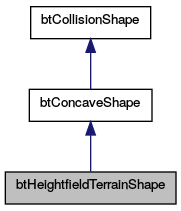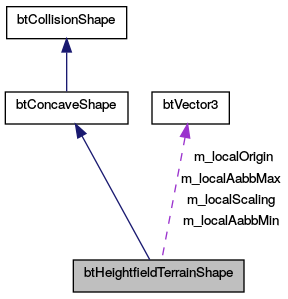btHeightfieldTerrainShape simulates a 2D heightfield terrain More...
#include <btHeightfieldTerrainShape.h>


Public Member Functions | |
| BT_DECLARE_ALIGNED_ALLOCATOR () | |
| btHeightfieldTerrainShape (int heightStickWidth, int heightStickLength, const void *heightfieldData, btScalar heightScale, btScalar minHeight, btScalar maxHeight, int upAxis, PHY_ScalarType heightDataType, bool flipQuadEdges) | |
| preferred constructor More... | |
| btHeightfieldTerrainShape (int heightStickWidth, int heightStickLength, const void *heightfieldData, btScalar maxHeight, int upAxis, bool useFloatData, bool flipQuadEdges) | |
| legacy constructor More... | |
| virtual | ~btHeightfieldTerrainShape () |
| void | setUseDiamondSubdivision (bool useDiamondSubdivision=true) |
| void | setUseZigzagSubdivision (bool useZigzagSubdivision=true) |
| could help compatibility with Ogre heightfields. See https://code.google.com/p/bullet/issues/detail?id=625 More... | |
| virtual void | getAabb (const btTransform &t, btVector3 &aabbMin, btVector3 &aabbMax) const |
| getAabb returns the axis aligned bounding box in the coordinate frame of the given transform t. More... | |
| virtual void | processAllTriangles (btTriangleCallback *callback, const btVector3 &aabbMin, const btVector3 &aabbMax) const |
| process all triangles within the provided axis-aligned bounding box More... | |
| virtual void | calculateLocalInertia (btScalar mass, btVector3 &inertia) const |
| virtual void | setLocalScaling (const btVector3 &scaling) |
| virtual const btVector3 & | getLocalScaling () const |
| virtual const char * | getName () const |
 Public Member Functions inherited from btConcaveShape Public Member Functions inherited from btConcaveShape | |
| BT_DECLARE_ALIGNED_ALLOCATOR () | |
| btConcaveShape () | |
| virtual | ~btConcaveShape () |
| virtual btScalar | getMargin () const |
| virtual void | setMargin (btScalar collisionMargin) |
 Public Member Functions inherited from btCollisionShape Public Member Functions inherited from btCollisionShape | |
| BT_DECLARE_ALIGNED_ALLOCATOR () | |
| btCollisionShape () | |
| virtual | ~btCollisionShape () |
| virtual void | getBoundingSphere (btVector3 ¢er, btScalar &radius) const |
| virtual btScalar | getAngularMotionDisc () const |
| getAngularMotionDisc returns the maximus radius needed for Conservative Advancement to handle time-of-impact with rotations. More... | |
| virtual btScalar | getContactBreakingThreshold (btScalar defaultContactThresholdFactor) const |
| void | calculateTemporalAabb (const btTransform &curTrans, const btVector3 &linvel, const btVector3 &angvel, btScalar timeStep, btVector3 &temporalAabbMin, btVector3 &temporalAabbMax) const |
| calculateTemporalAabb calculates the enclosing aabb for the moving object over interval [0..timeStep) result is conservative More... | |
| bool | isPolyhedral () const |
| bool | isConvex2d () const |
| bool | isConvex () const |
| bool | isNonMoving () const |
| bool | isConcave () const |
| bool | isCompound () const |
| bool | isSoftBody () const |
| bool | isInfinite () const |
| isInfinite is used to catch simulation error (aabb check) More... | |
| int | getShapeType () const |
| virtual btVector3 | getAnisotropicRollingFrictionDirection () const |
| the getAnisotropicRollingFrictionDirection can be used in combination with setAnisotropicFriction See Bullet/Demos/RollingFrictionDemo for an example More... | |
| void | setUserPointer (void *userPtr) |
| optional user data pointer More... | |
| void * | getUserPointer () const |
| virtual int | calculateSerializeBufferSize () const |
| virtual const char * | serialize (void *dataBuffer, btSerializer *serializer) const |
| fills the dataBuffer and returns the struct name (and 0 on failure) More... | |
| virtual void | serializeSingleShape (btSerializer *serializer) const |
Protected Member Functions | |
| virtual btScalar | getRawHeightFieldValue (int x, int y) const |
| This returns the "raw" (user's initial) height, not the actual height. More... | |
| void | quantizeWithClamp (int *out, const btVector3 &point, int isMax) const |
| given input vector, return quantized version More... | |
| void | getVertex (int x, int y, btVector3 &vertex) const |
| this returns the vertex in bullet-local coordinates More... | |
| void | initialize (int heightStickWidth, int heightStickLength, const void *heightfieldData, btScalar heightScale, btScalar minHeight, btScalar maxHeight, int upAxis, PHY_ScalarType heightDataType, bool flipQuadEdges) |
| protected initialization More... | |
Protected Attributes | |
| btVector3 | m_localAabbMin |
| btVector3 | m_localAabbMax |
| btVector3 | m_localOrigin |
| int | m_heightStickWidth |
| terrain data More... | |
| int | m_heightStickLength |
| btScalar | m_minHeight |
| btScalar | m_maxHeight |
| btScalar | m_width |
| btScalar | m_length |
| btScalar | m_heightScale |
| union { | |
| const unsigned char * m_heightfieldDataUnsignedChar | |
| const short * m_heightfieldDataShort | |
| const btScalar * m_heightfieldDataFloat | |
| const void * m_heightfieldDataUnknown | |
| }; | |
| PHY_ScalarType | m_heightDataType |
| bool | m_flipQuadEdges |
| bool | m_useDiamondSubdivision |
| bool | m_useZigzagSubdivision |
| int | m_upAxis |
| btVector3 | m_localScaling |
 Protected Attributes inherited from btConcaveShape Protected Attributes inherited from btConcaveShape | |
| btScalar | m_collisionMargin |
 Protected Attributes inherited from btCollisionShape Protected Attributes inherited from btCollisionShape | |
| int | m_shapeType |
| void * | m_userPointer |
Detailed Description
btHeightfieldTerrainShape simulates a 2D heightfield terrain
The caller is responsible for maintaining the heightfield array; this class does not make a copy.
The heightfield can be dynamic so long as the min/max height values capture the extremes (heights must always be in that range).
The local origin of the heightfield is assumed to be the exact center (as determined by width and length and height, with each axis multiplied by the localScaling).
NOTE: be careful with coordinates. If you have a heightfield with a local min height of -100m, and a max height of +500m, you may be tempted to place it at the origin (0,0) and expect the heights in world coordinates to be -100 to +500 meters. Actually, the heights will be -300 to +300m, because bullet will re-center the heightfield based on its AABB (which is determined by the min/max heights). So keep in mind that once you create a btHeightfieldTerrainShape object, the heights will be adjusted relative to the center of the AABB. This is different to the behavior of many rendering engines, but is useful for physics engines.
Most (but not all) rendering and heightfield libraries assume upAxis = 1 (that is, the y-axis is "up"). This class allows any of the 3 coordinates to be "up". Make sure your choice of axis is consistent with your rendering system.
The heightfield heights are determined from the data type used for the heightfieldData array.
- PHY_UCHAR: height at a point is the uchar value at the grid point, multipled by heightScale. uchar isn't recommended because of its inability to deal with negative values, and low resolution (8-bit).
- PHY_SHORT: height at a point is the short int value at that grid point, multipled by heightScale.
- PHY_FLOAT: height at a point is the float value at that grid point. heightScale is ignored when using the float heightfield data type.
Whatever the caller specifies as minHeight and maxHeight will be honored. The class will not inspect the heightfield to discover the actual minimum or maximum heights. These values are used to determine the heightfield's axis-aligned bounding box, multiplied by localScaling.
For usage and testing see the TerrainDemo.
Definition at line 71 of file btHeightfieldTerrainShape.h.
Constructor & Destructor Documentation
| btHeightfieldTerrainShape::btHeightfieldTerrainShape | ( | int | heightStickWidth, |
| int | heightStickLength, | ||
| const void * | heightfieldData, | ||
| btScalar | heightScale, | ||
| btScalar | minHeight, | ||
| btScalar | maxHeight, | ||
| int | upAxis, | ||
| PHY_ScalarType | heightDataType, | ||
| bool | flipQuadEdges | ||
| ) |
preferred constructor
This constructor supports a range of heightfield data types, and allows for a non-zero minimum height value. heightScale is needed for any integer-based heightfield data types.
Definition at line 23 of file btHeightfieldTerrainShape.cpp.
| btHeightfieldTerrainShape::btHeightfieldTerrainShape | ( | int | heightStickWidth, |
| int | heightStickLength, | ||
| const void * | heightfieldData, | ||
| btScalar | maxHeight, | ||
| int | upAxis, | ||
| bool | useFloatData, | ||
| bool | flipQuadEdges | ||
| ) |
legacy constructor
The legacy constructor assumes the heightfield has a minimum height of zero. Only unsigned char or floats are supported. For legacy compatibility reasons, heightScale is calculated as maxHeight / 65535 (and is only used when useFloatData = false).
Definition at line 36 of file btHeightfieldTerrainShape.cpp.
|
virtual |
Definition at line 123 of file btHeightfieldTerrainShape.cpp.
Member Function Documentation
| btHeightfieldTerrainShape::BT_DECLARE_ALIGNED_ALLOCATOR | ( | ) |
|
virtual |
Implements btCollisionShape.
Definition at line 396 of file btHeightfieldTerrainShape.cpp.
|
virtual |
getAabb returns the axis aligned bounding box in the coordinate frame of the given transform t.
Implements btCollisionShape.
Definition at line 129 of file btHeightfieldTerrainShape.cpp.
|
virtual |
Implements btCollisionShape.
Definition at line 407 of file btHeightfieldTerrainShape.cpp.
|
inlinevirtual |
Implements btCollisionShape.
Definition at line 163 of file btHeightfieldTerrainShape.h.
|
protectedvirtual |
This returns the "raw" (user's initial) height, not the actual height.
The actual height needs to be adjusted to be relative to the center of the heightfield's AABB.
Definition at line 151 of file btHeightfieldTerrainShape.cpp.
|
protected |
this returns the vertex in bullet-local coordinates
Definition at line 189 of file btHeightfieldTerrainShape.cpp.
|
protected |
protected initialization
Handles the work of constructors so that public constructors can be backwards-compatible without a lot of copy/paste.
Definition at line 55 of file btHeightfieldTerrainShape.cpp.
|
virtual |
process all triangles within the provided axis-aligned bounding box
basic algorithm:
- convert input aabb to local coordinates (scale down and shift for local origin)
- convert input aabb to a range of heightfield grid points (quantize)
- iterate over all triangles in that subset of the grid
Implements btConcaveShape.
Definition at line 283 of file btHeightfieldTerrainShape.cpp.
|
protected |
given input vector, return quantized version
This routine is basically determining the gridpoint indices for a given input vector, answering the question: "which gridpoint is closest to the provided point?".
"with clamp" means that we restrict the point to be in the heightfield's axis-aligned bounding box.
Definition at line 262 of file btHeightfieldTerrainShape.cpp.
|
virtual |
Implements btCollisionShape.
Definition at line 403 of file btHeightfieldTerrainShape.cpp.
|
inline |
Definition at line 147 of file btHeightfieldTerrainShape.h.
|
inline |
could help compatibility with Ogre heightfields. See https://code.google.com/p/bullet/issues/detail?id=625
Definition at line 150 of file btHeightfieldTerrainShape.h.
Member Data Documentation
| union { ... } |
|
protected |
Definition at line 95 of file btHeightfieldTerrainShape.h.
|
protected |
Definition at line 94 of file btHeightfieldTerrainShape.h.
| const btScalar* btHeightfieldTerrainShape::m_heightfieldDataFloat |
Definition at line 90 of file btHeightfieldTerrainShape.h.
| const short* btHeightfieldTerrainShape::m_heightfieldDataShort |
Definition at line 89 of file btHeightfieldTerrainShape.h.
| const void* btHeightfieldTerrainShape::m_heightfieldDataUnknown |
Definition at line 91 of file btHeightfieldTerrainShape.h.
| const unsigned char* btHeightfieldTerrainShape::m_heightfieldDataUnsignedChar |
Definition at line 88 of file btHeightfieldTerrainShape.h.
|
protected |
Definition at line 85 of file btHeightfieldTerrainShape.h.
|
protected |
Definition at line 80 of file btHeightfieldTerrainShape.h.
|
protected |
terrain data
Definition at line 79 of file btHeightfieldTerrainShape.h.
|
protected |
Definition at line 84 of file btHeightfieldTerrainShape.h.
|
protected |
Definition at line 75 of file btHeightfieldTerrainShape.h.
|
protected |
Definition at line 74 of file btHeightfieldTerrainShape.h.
|
protected |
Definition at line 76 of file btHeightfieldTerrainShape.h.
|
protected |
Definition at line 101 of file btHeightfieldTerrainShape.h.
|
protected |
Definition at line 82 of file btHeightfieldTerrainShape.h.
|
protected |
Definition at line 81 of file btHeightfieldTerrainShape.h.
|
protected |
Definition at line 99 of file btHeightfieldTerrainShape.h.
|
protected |
Definition at line 96 of file btHeightfieldTerrainShape.h.
|
protected |
Definition at line 97 of file btHeightfieldTerrainShape.h.
|
protected |
Definition at line 83 of file btHeightfieldTerrainShape.h.
The documentation for this class was generated from the following files:
 1.8.6
1.8.6